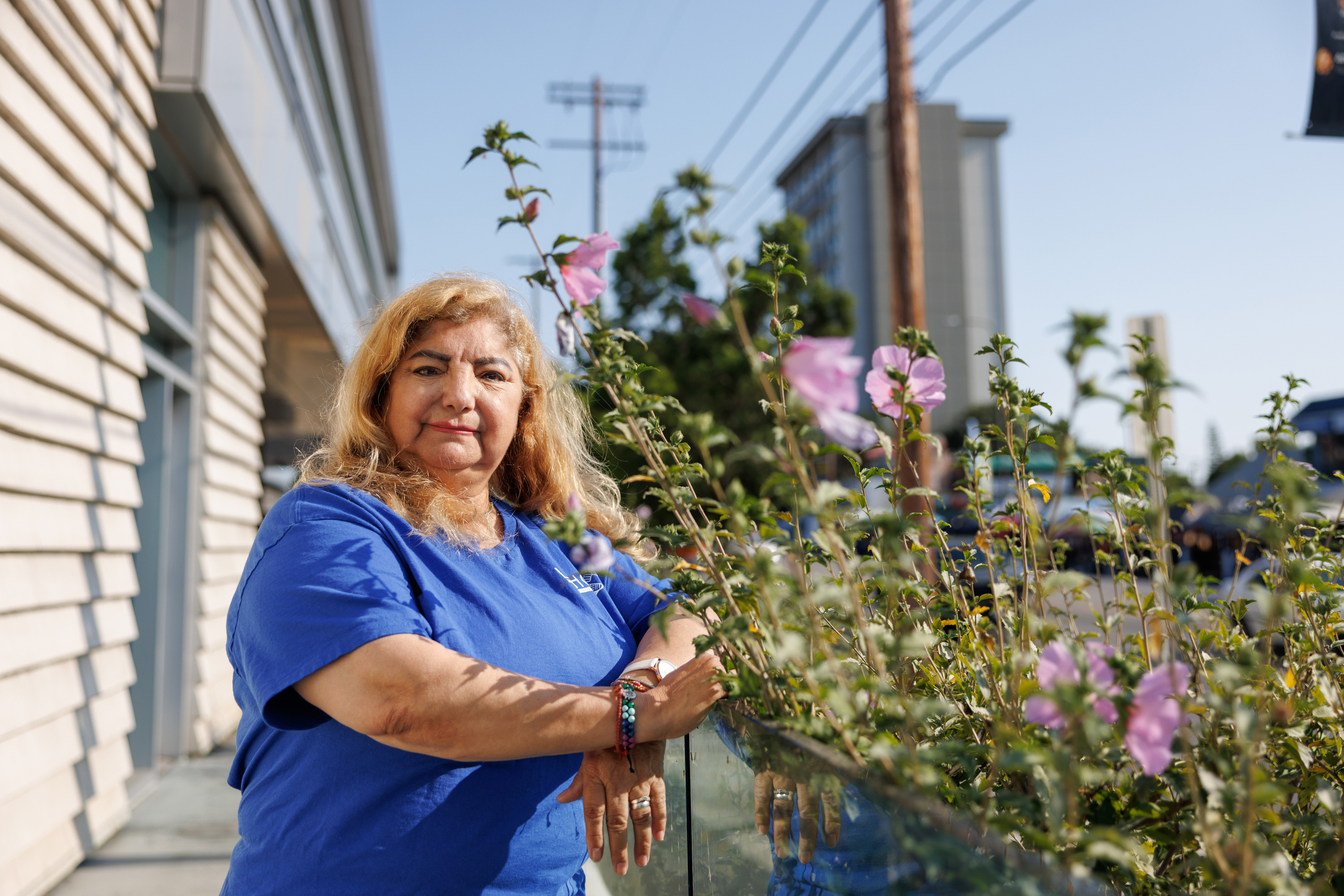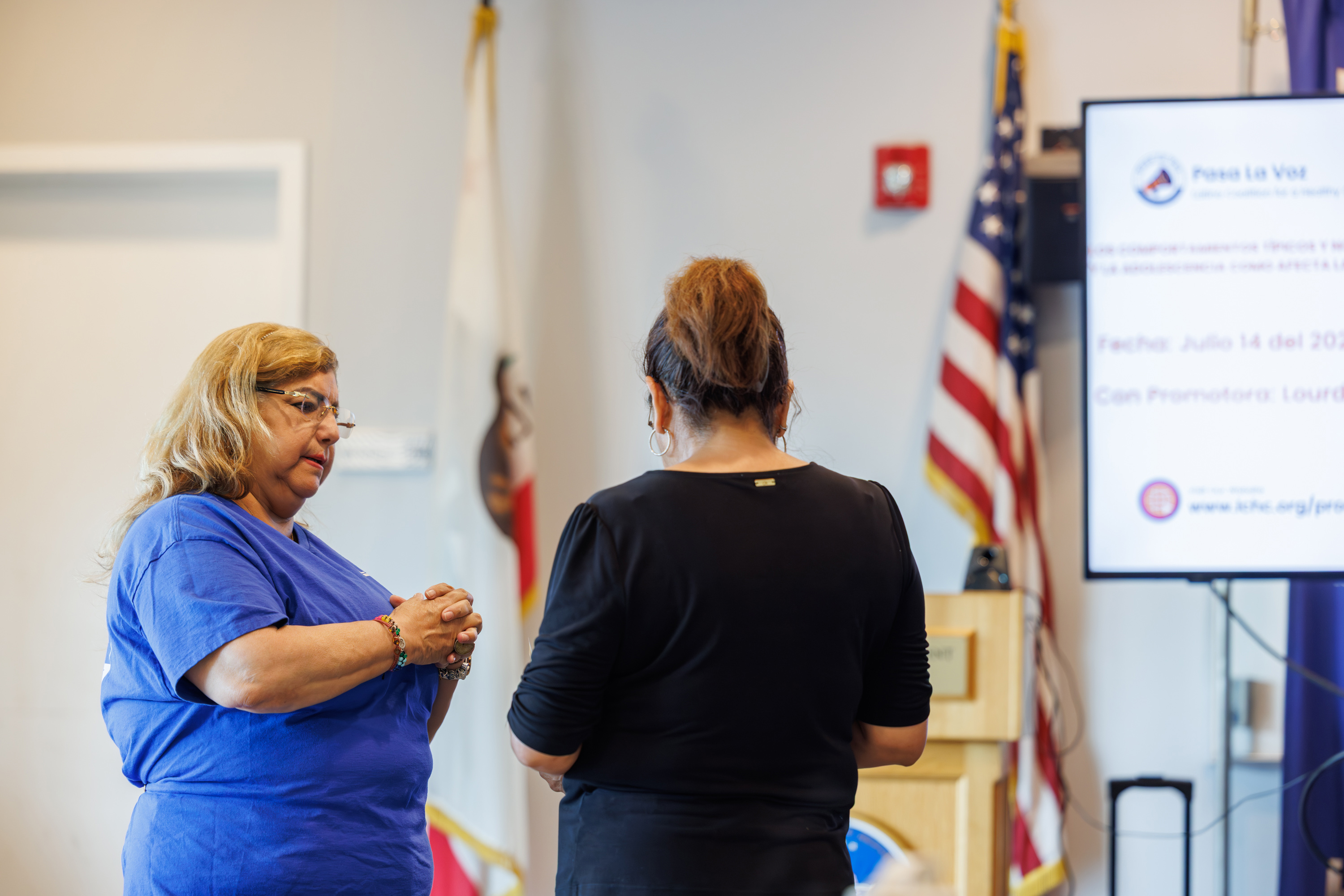Fortina Hernández is known as “the one who knows it all.”
For greater than 20 years, the neighborhood well being employee has supported a whole lot of households all through southeast Los Angeles by serving to them join meals help, sharing details about reasonably priced well being protection, and managing drugs for his or her continual diseases. She’s guided by the expression “an ounce of prevention is worth a pound of cure.”
However she makes solely round $20 an hour from a neighborhood well being group and should maintain down a second job to make ends meet. “They pay us very little and expect too much,” she stated in Spanish. “We build trust. We offer support. We’re the shoulder people rely on, but we don’t get fair wages.”
California appeared to professionalize hundreds of neighborhood well being staff resembling Hernández to enhance the well being of immigrant populations, notably Hispanic residents, who typically expertise larger charges of continual illnesses, are extra prone to be uninsured, and face extra cultural and linguistic obstacles when making an attempt to entry providers. Research present their work might scale back hospitalizations in addition to emergency room and pressing care visits.
The state hewed intently to a sequence of knowledgeable suggestions put out in 2019 to standardize coaching and certification, combine these staff into the well being care workforce, and supply honest wages, together with reimbursements by Medi-Cal, the state’s Medicaid medical health insurance program, to compensate for work that historically has been performed on a volunteer foundation or for low pay. However six years in, California has backed out of lots of these initiatives.
The state has eradicated a certification program and rolled again practically all funding to coach and increase this workforce regardless that it set a objective of 25,000 staff by this yr. Though Medi-Cal started protecting their providers, taking part well being plans set uneven billing necessities, making it tough for staff to get reimbursed. And the state didn’t comply with by on a deliberate pay increase.
With federal funding cuts simply handed and President Donald Trump focusing on immigrants for deportation — even sharing private Medicaid knowledge with the Division of Homeland Safety — advocates concern California is abandoning its well being fairness initiative for immigrants, folks of coloration, and other people with low incomes after they say that effort is required most.
“We’re in a very dire situation right now,” stated Cary Sanders, senior coverage director for the California Pan-Ethnic Well being Community, a statewide well being fairness advocacy group.
A spokesperson for Gov. Gavin Newsom, Elana Ross, stated “the state has taken difficult but necessary steps to ensure fiscal stability” and that the administration continues to have a dialogue with neighborhood well being staff. Ross added that the Democratic governor, a potential presidential candidate, stays dedicated to defending immigrants being focused by the Trump administration.
‘Our Office Is on the Street’
There are greater than 60,000 neighborhood well being staff nationwide, together with roughly 9,200 in California, and this workforce is projected to develop 13% over the following decade, 3 times as quick as for all occupations, in response to 2024 knowledge from the U.S Bureau of Labor Statistics. However consultants say these numbers are an undercount given the assorted titles neighborhood well being staff maintain and that many work exterior of well being care and governmental establishments.
Group well being employee is an umbrella time period that features peer supporters and neighborhood well being representatives. These staff, typically often called promotores, are usually ladies who work in clinics, hospitals, public well being departments, and native nonprofits, locations the place they’re trusted and have a grasp of their neighborhood’s most urgent well being wants.
Apart from serving to folks handle continual diseases resembling coronary heart illness and diabetes, they promote reproductive well being, kids’s well being, and oral hygiene, they usually assist seniors with dementia forestall accidents and evaluate drugs. They will make folks really feel protected when reporting home violence and different abuses. In addition they join folks to housing and meals help. “The community health worker is not sitting at a desk,” Hernández stated. “Our office is on the street.”
Again in 2019, the California Future Well being Workforce Fee really useful integrating neighborhood well being staff into the well being care system, and in 2022, the state licensed $281 million over three years for the California Division of Well being Care Entry and Info, which oversees well being care workforce growth, to recruit, practice, and certify them.
The company sought to standardize coaching and certification, however some neighborhood teams feared that may create obstacles to entry by not giving sufficient credit score for lived experiences and cultural competency. However simply because the company provided extra flexibility and allowed community-based coaching, the state slashed $250 million in funding final yr on account of price range constraints. This yr, the certification program was formally eradicated.
Spokesperson Andrew DiLuccia stated the company is now contemplating a program to accredit neighborhood organizations fairly than particular person staff and plans to spend its remaining $12 million on technical help, workforce growth, and salaries for these working with immigrant communities.
In keeping with the Nationwide Academy for State Well being Coverage, 32 different states supply a voluntary or obligatory neighborhood well being employee certification program.
Some neighborhood well being advocates say California’s lacking a possibility to carve a profession path for this workforce. At present, some programs provided by nonprofits, counties, and faculties require a charge, a level, English fluency, or prior expertise. Most are concentrated within the San Francisco or Los Angeles space, leaving coaching deserts in a lot of the state.
Lourdes Bernis, a dentist from Ecuador, is a mannequin for the way neighborhood well being staff might be built-in into the well being care system. She started as a volunteer promotora greater than a decade in the past and in 2019 acquired free coaching from Los Angeles County, permitting her to maneuver right into a full-time job with advantages for the county’s Division of Psychological Well being to assist Spanish-speaking ladies handle melancholy and anxiousness as they get better from drug use.
Bernis now plans to turn out to be a peer-to-peer assist specialist inside hospitals and clinics. In the meantime, lots of her colleagues with a long time of expertise stay caught in low-paying roles and may’t afford coaching to advance. “There are promotoras who have 20 to 25 years of experience, but they are still volunteering,” Bernis stated in Spanish.

Medi-Cal’s Function
To pay neighborhood well being staff, Medi-Cal started protecting their providers in July 2022, however California suspended a deliberate pay improve for them after voters authorized Proposition 35, which hiked the pay of physicians, hospitals, neighborhood clinics, and different suppliers as a substitute. Since then, the state has but to determine a uniform system for the way well being plans ought to contract with organizations that make use of neighborhood well being staff.
“We have to jump through hoops,” stated Maria Lemus, government director at Visión y Compromiso, a Los Angeles-based nonprofit representing neighborhood well being staff. “It just causes havoc, because each plan could have different requirements.”
Lemus stated it took the group practically six months to determine fee with one well being plan.
And although Medi-Cal reimbursements are tied to particular person duties, starting from $9.46 to $27.54 for half-hour of labor, advocates say they aren’t totally compensated for the time they spend constructing belief and following up with sufferers. Advocates say these staff ought to earn at the very least $30 a go to, with advantages, however many earn about $21 an hour, typically with out advantages.
Advocates say they’re stunned by how occasionally these providers are utilized in a program with 15 million Californians. Greater than 16,000 Medi-Cal enrollees used these providers within the first yr, rising to 68,000 final yr, in response to state knowledge. “I don’t think it’s reached the potential that the governor talked about, and that we all imagined that it could possibly achieve,” Sanders stated.
Griselda Melgoza, a spokesperson for the California Division of Well being Care Companies, stated the company, which administers Medi-Cal, has seen “a steady, upward trend” and believes the info underestimates utilization as a result of the profit is typically bundled with different providers.
A proposal to evaluate whether or not Medi-Cal managed care plans are doing sufficient outreach and schooling to enrollees about neighborhood well being providers died this yr.
Extra Essential Than Ever
With well being funding cuts from the Trump administration and passage of the GOP’s tax and spending laws, advocates concern there will likely be even much less funding and assist for neighborhood well being employee positions, shrinking a workforce tackling well being disparities. Already, Fresno County’s Division of Public Well being stated it has lower its neighborhood well being staff by greater than half, from 49 positions to twenty.
But, outreach is extra essential than ever. Because the Trump administration continues immigration raids, which seem to have focused at the very least one well being clinic within the state, advocates and coverage researchers say neighborhood well being staff might act as intermediaries for immigrant sufferers afraid to hunt medical care in hospitals and clinics.
And not using a state certification program, no raises, and dwindling coaching funds, the trail to professionalizing neighborhood well being staff is unclear, leaving staff feeling left behind.
“The community trusts me,” stated Hernández, the veteran neighborhood well being employee, “but at the government level, there’s still a long way to go before this work is valued and fairly compensated.”

This text was produced by KFF Well being Information, which publishes California Healthline, an editorially impartial service of the California Well being Care Basis.




